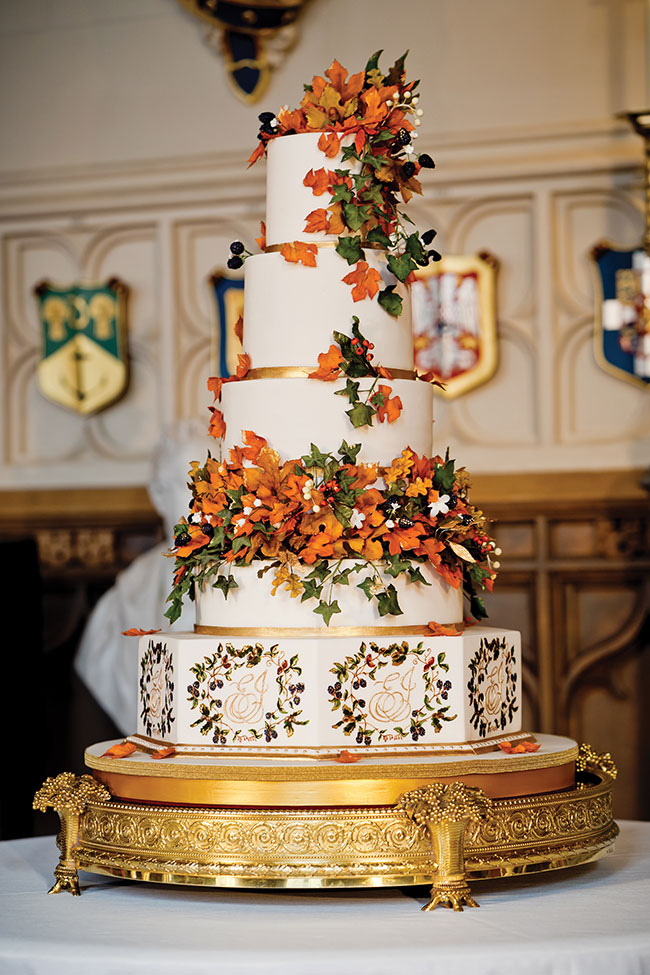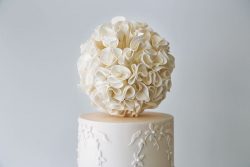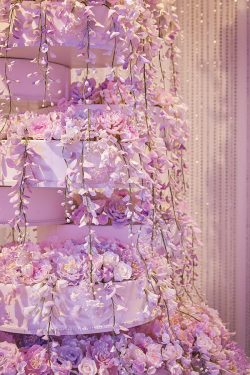
International Flair
June 16, 2020
By Karen Barr
A global spin on traditional cakes
 Princess Eugenie and Jack Brookshank’s wedding cake, designed by Sophie Cabot. Photo credit: Joe Short
Princess Eugenie and Jack Brookshank’s wedding cake, designed by Sophie Cabot. Photo credit: Joe Short It is time to take a spin around the world to see what is trending in global cake designs. Flavours and trends may change, and from a North American standpoint we may see the same shapes, colours and flavours. Bakers Journal looks at what other countries’ top wedding cake designers are doing to make show-stopping cakes worth celebrating.
Sophie Cabot, London, England, United Kingdom
Sophie Cabot’s name sound familiar, its because she is the London-based cake designer chosen to create Princess Eugenie’s wedding cake for her marriage to Jack Brooksbank. The former costume designer was up to the challenge, creating a five-tiered cake, adorned with hand made, seasonally inspired orange leaves, for the fall nuptials. The couple also requested ivy vines be part of the celebrational cake, again made with sugar, a nod to their home Ivy Cottage, on the grounds of Kensington Palace.
“I was very happy to hear their delight with the result,” says Cabot, who begin baking the three tiers of red velvet cake and two tiers of chocolate sponge cake, at Buckingham Palace, two days before the wedding party and the 850 guests were to arrive. Newspapers reported the cake required 400 eggs, 53 packs of unsalted butter, 33 pounds of organic self-rising flour and 44 pounds of sugar. Queen Victoria would have loved it.
The average sized wedding cake Cabot creates is three tiers high. “Flavours and popularity change with the season and I keep mine classic. Over the winter and autumn months, a rich chocolate, red velvet, or carrot are strong choices. However, for spring and summer, the lighter flavours are more popular, such as lemon and Victoria sponge.”
As for colour, Cabot says, “For wedding cakes you can’t beat white, or a cream base colour.” She has also received requests for blue, this year’s Pantone colour. “Metallics are still very popular and give the cake a wonderful pop.”
When it comes to fine details Cabot says, “The piping I do is with royal icing. It is very delicate and applied with very fine nozzles. Mostly small pearls around the base of the tiers, or even text.”
“I have so many favourite recent cakes,” says Cabot, when asked to pick just two. But then she decides, “The first was finished with a textured white chocolate ganache and decorated with sugar flowers. It was displayed at Kew Gardens. The other was finished with ombre blue fondant and decorated with masses of small, white, royal icing piped pearls. This cake was displayed at the Natural History Museum.”

Faye Cahill’s eye for detail and skill with sugar work make her cake toppers stand out. Photo credit: Violet Bechara
Faye Cahill Cake Design, Sydney, Australia
Cake designer, Faye Cahill, is known for her clean lines, stylized sugar work and refined details, such as piped lace work, that looks just like the real thing. In the early days of social media, she set the standards in Australia, for what a wedding cake should look like, with her use of edible gold, silver leaf, lustre finishes, as well as the taller tier cake heights.
“Many people are choosing fresh flavours, like lemon or passionfruit. I have an amazing vanilla bean ganache that is hugely popular as a filling. And then there is chocolate, red velvet and salted caramel.”
She tends to use rolled fondant over a ganache layer. “It’s the smoothest base for decoration, such as lace,” Cahill says simply. “When I do a soft finish, I prefer to use whipped ganache, rather than buttercream, due to stability.”
“White always looks soft and romantic and has a classic look. But we also see many neutrals such as taupe, cream, nude, blush and even some stronger colours.” As for metallics Cahill says, “I see more gold as accents, than silver. Copper and rose gold accents are chosen less than a year or two ago.”
And about the gorgeous lace work? “I like to combine a few techniques in my lace patterns. It might have some fondant applique such as lines and flowers. Occasionally, I add some flexible areas, like fishnet or tulle. Then, I finish with piping with royal icing.”
And which wedding cakes have been the designer’s most memorable lately? “One of my favourites was a huge cake, with lace and abstract flowers. All white and pearl white. The other project I really enjoyed was a display piece for Weddings 2, The Posh Frock Shop, which was a collaboration with Cake International in November 2019. Each artist chose a gown by designer Ian Stewart and created a cake inspired by it. Mine was based on a heavily beaded number. I used a lot of edible beads and pearls.”
Ana Parzych Custom Cakes, Cheshire, Connecticut, United States

Ana Parzych uses colours and textures that incorporates the elements of the venue’s architecture. PHOTO CREDITs: Mel Barlow & Co., Freire Photography
“I am a classically trained artist and I think it shows in my work,” says Ana Parzych, who studied art and graphic design. Her shop is in an ideal location, set between Boston and New York and within driving distance of Newport.
Parzych makes only 30 to 40 cakes per year. Most are quite lavish. Wedding celebrations are often in five-star New York hotels or luxurious mansions on Rhode Island. “The venue is always a starting point,” she says, noting the client usually want the cake have elements of the venue’s design and architecture. This means lots of gold and metallics. Flowers decorating the room are also carried into the design.
“My average cake has five tiers and at least 100 flowers,” says Parzych. She hand crafts all her flowers from gum paste for durability. “I have to make flowers for my cakes many months in advance.” More flowers are delicately piped or painted on. “I like to add a little colour and shimmer when I am done,”
Her customer base in mainly in the United States, but she has made a trip out to Dubai. “There is always a cake every year that we have to travel with. Once, we had to take a ferry out to Nantucket, on a three-hour ferry ride, in a storm,” she remembers with a laugh.
One of the most opulent wedding cakes she ever prepared was for the daughter of a billionaire, who planned a wedding in Las Vegas. The cake was 32 tiers high. The flower of choice: wisteria, a difficult flower to create, as each stem has hundreds of tiny flowers.
“I had the flowers shipped across the country in a van ahead of time. Then, I flew down five days prior, with my team. We were given a ballroom filled with tables, right beside the venue, to work from. Flowers were everywhere! We had to create an additional 500 flowers, one for each miniature cake for guests.”
As for cake flavours Parzych points to her toasted almond cake, with dulce de leche and apricot preserve filling as her most popular. “But I never make just one cake flavour. Clients usually want at least two.”
Other popular cake flavours include coconut, almond, pistachio and hazelnut. Fruity fillings most requested are coconut, passionfruit, guava, coconut, rose water or lavender mixed, in frothy Italian meringue or creme mousseline.
And she has not forgotten about service presentation. “We like to see out cakes served with freeze dried rose petals for garnish. It helps create pretty plates,”
And that’s a round up of what in trending in the world of international wedding cakes.
Karen Barr writes about arts, culture and cuisine. She is a graduate of George Brown College and is a Red Seal pastry chef.
Print this page
Leave a Reply